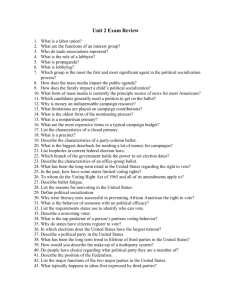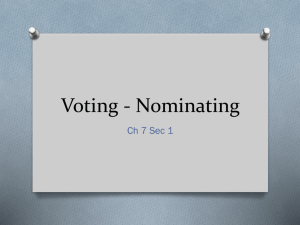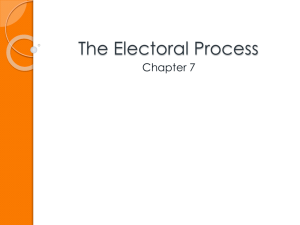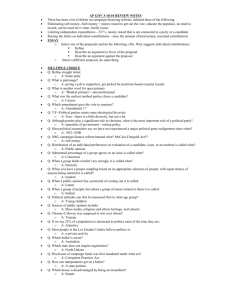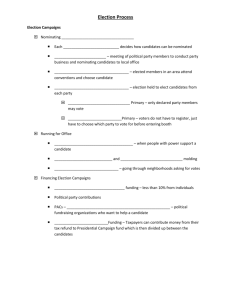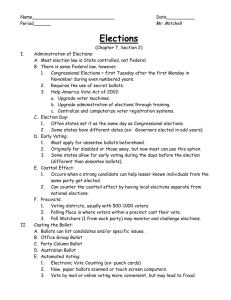Chapter 7
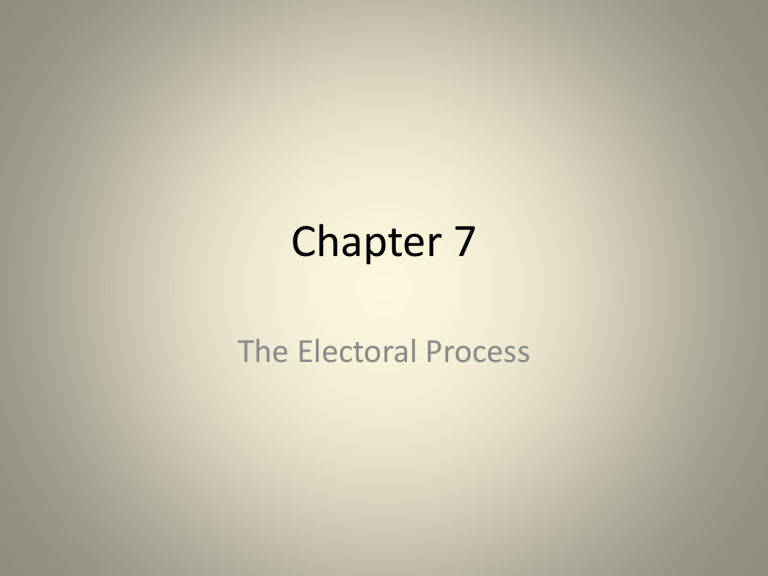
Chapter 7
The Electoral Process
Section 1
The Nominating Process
A Critical 1 st Step
• Nomination - naming of those who will seek office
• Prime function of political parties
• Impact on the right to vote
– Nomination process
– General Electionsmake final selection of office holder
A Critical First Step
• During the process voters are narrowing the field of candidates before the general election
• 5 different ways to nominate candidates
Ways to Nominate
Self-Announcement
• Oldest form
• Found mainly in small towns and rural communities
• Person running announces the decision to run
– Unhappy with party’s choice
– Failed to win nomination
– Write in candidates
Caucus
• Group of like minded people who meet to select candidates
• Originally closed meetings
• As parties developed they took over the process
• As U.S. grew it wasn’t a true representation
– Jackson, Clay and J. Q. Adams boycotted it.
Ways to Nominate
Convention
• Took over after Caucus failed
• Anti-Masons were the first in 1831
• All major party nominees have been chosen by convention ever since
Ways to Nominate
Direct Primary
Closed Primary
• Only declared party members can vote
• 26 states and D.C. use this method
• Voters register which party they are affiliated with
Open Primary
• Any qualified voter can take vote
• Private: Ballots for both parties that are being polled
• Public: Voter must ask for which ballot they want to participate in.
• Blanket Primary
– All voters are given the same ballot regardless of party
Closed Primary
Advantages
• Prevents one party from
“raiding” the other’s primary to choose a weaker candidate
• Helps make candidates more responsive to the party
• Helps make voters more thoughtful
Disadvantages
• Compromises secrecy of the ballot since voters must declare their party
• Excludes independent voters
Open Primary
Advantages
• Voters are not forced to declare a party in public
• Open to independent voters
Disadvantages
• Permits raiding
• Undercuts the concept of party loyalty and responsibility
Direct Primary
Runoff Primary
• In some states a majority is needed to win the nomination
• If nobody gets the majority then another election will be held with the top 2 vote getters from the original election
Direct Primary
Nonpartisan Primary
• School and municipal positions
• Candidates are not identified by party labels
Direct Primary
Evaluation
• Voter turnout is half of what a general election is
– Long ballots, having to declare party, not being able to declare a party, etc.
• Campaigns can be expensive
– Well qualified people choose not to run
• Creates division in party
– Close contest can divide
Direct Primary
Presidential Primary
• Only one part of the nominating process
• States can choose delegates who go to the national convention
• And/or voters choose contenders for their parties nomination
Petition
• For those who are not nominated by a major party
• Usually at the local level
• Potential candidate needs to get a certain amount of signatures on their petition, required by state law
– The higher the position, the more signatures needed
Section 2
Elections
“Don’t Vote? Don’t Complain!”
Administration of Elections
• Democracy only works if elections are free, honest and accurate.
• Laws about qualifications, registration and provisions for direct primary protect the integrity of voting
Administration of Elections
• Extent of Federal Control
– Most election law is state law
– Constitution allows Congress to set times and dates for elections
• Tues. after 1 st Monday in November of even numbered years
– Require secret ballots
– Voting rights for people
– Regulate campaign practices
• Money
Administration of Elections
• When Elections are held
– Most states follow the day set by the fed. Gov’t
• Prevents elections from falling on Sunday (Church and
State)
• Keeps elections from falling on the 1 st of the month
(payday)
– No pressure from campaigns
Administration of Elections
• Early Voting
– Absentee voting- unable to get to regular polling places
• Ill or disabled
• Expecting to be away (business, college, vacation, etc)
• Serving in Armed Forces
• Mark the ballot, seal it and return to proper official
Administration of Elections
• Early Voting (Continued)
– 1/3 of states allow early voting
• More convenient
• Cast ballots over a period of days
Administration of Elections
• The Coattail Effect
– When a strong candidate attracts voters to other candidates on a party’s ticket
– Can also have a reverse effect
– Keeps people more involved
Precincts and Polling Places
• Precinct- a voting district
– Smallest geographic units for conducting elections
– Size = between 500 to 1,000 qualified voters
• Polling place- place where the voters vote
• Precinct board supervises the process
• County clerk or board draws lines, fixes voting locations and picks members of the precinct board
Precinct and Polling Places
• Board makes sure ballot machines/boxes are available
• Check to make sure only qualified voters vote
• Both parties have watchers
– May challenge any person who they think is not a qualified voter
Casting the Ballot
• Ballot- device by which a voter registers a choice
• Secret ballot
Casting the Ballot
• 5 types of ballots
– Australian Ballot
• Printed at public expense
• Lists the names of all candidates
• Given out only at the polls
• Marked in secret
Casting the Ballot
– Office Group Ballot (Massachusetts ballot)
• Candidates for an office are grouped together under the title of the office
• Used to be alphabetical but now rotated
– Party-Column Ballot (Indiana Ballot)
• Each party’s candidates are listed in a column under the party’s name
• Often time there is a marker to vote for all of the party members
– Politicians favor this ballot
Casting the Ballot
– Sample Ballots
• Handed out before an election
• Mailed, printed in newspapers
– Bedsheet Ballots
• Long list of candidates
• Vote for as many offices as possible = more democratic
• Very American type of ballot
Voting Machines and Innovations
• Thomas Edison had 1 st patent for voting machine
• Electronic vote counting (EDP)
– Punch card ballots
– Marked with ink (scantron)
Voting Machines and Innovations
• Vote by Mail Elections
– Ballot is sent to you, you vote, then mail it back
– Usually local elections
– Oregon now holds all elections by mail
– Some fear it goes against the secret ballot
– Some say it is the most fraud proof
• Better voter turnout
Voting Machines and Innovations
• Online voting
– Fear of hackers, viruses, lack of access, fraud
Section 3
Money and Elections
• Campaign Spending
– Cost varies for different offices
• President, Congress etc.
– TV ads, campaign managers, advertisements, pamphlets, buttons, posters, etc.
Sources of Funding
• Private and Public Sources
– Major source of income
– Small Contributors- 10% of voters
– Wealthy (Fat Cats)- Donate large amounts, in their best interests
– Candidates – help their own causes
– Non-Party groups – Political Action Committees
(PACs) Special interest groups
Sources of Funding
– Temporary organizations – groups formed for the immediate purposes of a campaign
• Hold their own fundraisers (dinners)
• Subsidy- a grant or gift of money, usually from a government
Sources of Funding
• Why people give
– Participation
– Believe in the cause
– Access to government
– Recognition
– Policies (change or kept the same)
Regulating Campaign Finance
• 1907- first regulation put on donations
– No corporation or national bank can make a money contribution to a federal campaign
• Federal Election Campaign Act of 1971
• FECA Amendments of 1974 (Watergate
Scandal) and 1976 (Buckley v Valeo)
Federal Election Commission
• Set up in 1974 to administer federal law with campaign finance
• An independent agency in the executive branch
• 6 appointed members, approved by Senate
• Laws cover 4 broad areas
FEC
• Disclosure Requirements
– Very detailed reports
– Who donated, how much, how they donated etc
– All contributions must be made through a single campaign committee
• Only that committee can spend the money
FEC
• Limits on Contributions
– No person can give more than $1,000 in a primary election or general election
– No more than $5,000 to a candidate or $20,000 to a party in a year
– Limited to $25,000 a year
FEC
• PAC Contributions
– Special interest groups for businesses and other organizations
– No corporation or union can donate
– PACs are created to fundraise and donate money
• BANKPAC, NEAPAC, etc.
FEC
– Pool their money together
– Give it to candidates who support their cause
– No more than $5,000 to one candidate or $10,000 per election cycle
– $15,000 a year to a party
– No overall limit
Limits on Expenditures
• Limits on presidential spending not congressional campaigns
• Buckley v Valeo (1976)
– Said money = freedom of speech
– Struck down limits to house or senate candidates
• Limit on how much the candidate can spend
• No person can spend more than $1,000
• Spending limits only apply to those who get money from the FEC
Public Funding of Pres. Campaigns
• Presidential Election Campaign Fund
– On Tax Return you can choose to donate $3 to the fund
• Helps fund pre convention campaigns, national conventions and presidential election campaigns
Pre-Convention Campaign
• To be eligible for public funds a candidate must raise $100,000 from individuals
• Must be in lots of $5,000 from 20 states
• No individual donation can be above $250
• FEC will match up to half of the overall limit of each candidate
National Convention
• If a Political Party applies for grant to pay for national convention they will get it
Presidential Election Campaigns
• Every major party nominee qualifies for subsidy to cover costs of campaign
• If they take the money then they can not spend more than given or accept money from outside sources
Presidential Election Campaigns
• Minor party candidate can qualify if
– They received 5% of the popular vote in the last election
– If they get 5% of popular vote in current election
• They will get the money after the election
Loopholes in the law
• Soft Money- money given to state and local party organizations
– PACs
– Support local voter registration, mailings, advertisements and education
Loopholes in the law
• Independent Campaign spending
– An individual does not donate but spends how they want to help a candidate
• Often against the other candidate
Loopholes in the law
• Issue ads
– Ads focused on public issues
– Do not specifically say “vote for Joe”
• Social sec., health care, foreign trade, etc.
